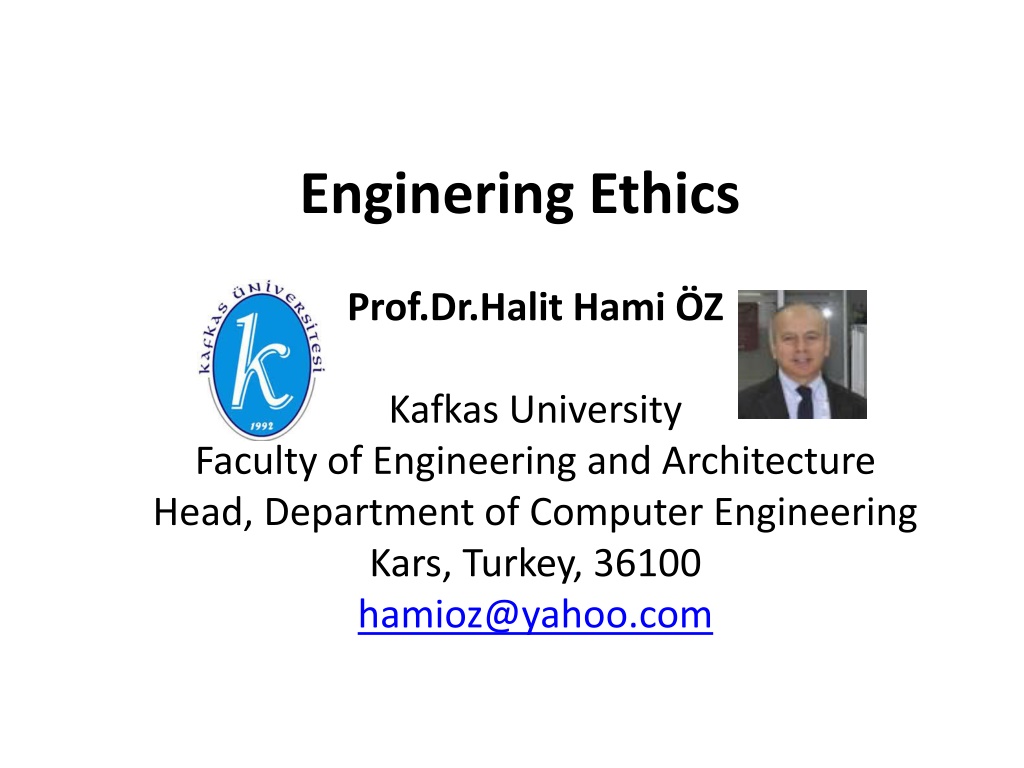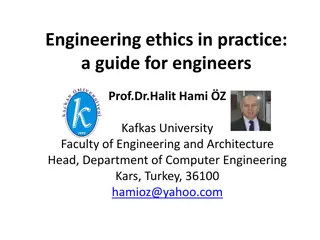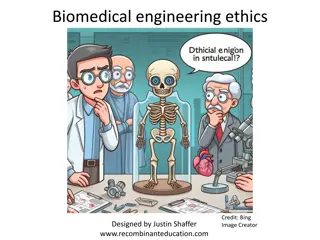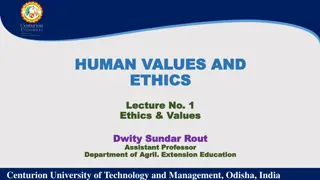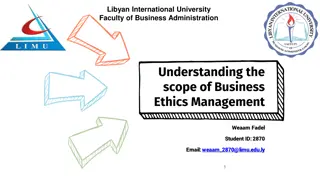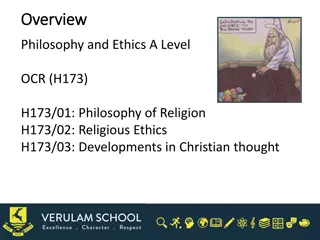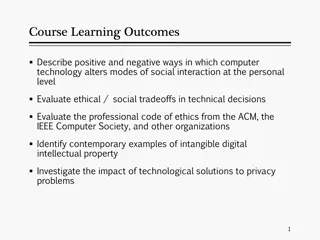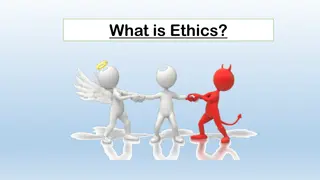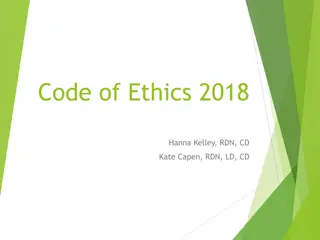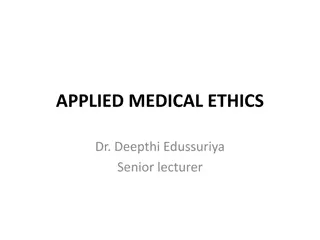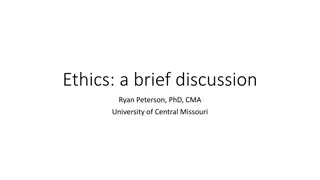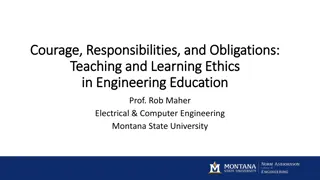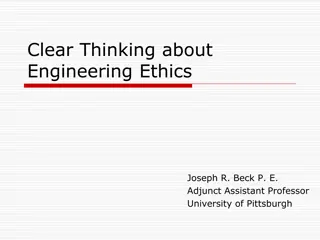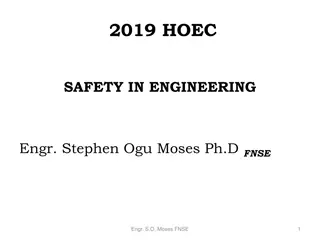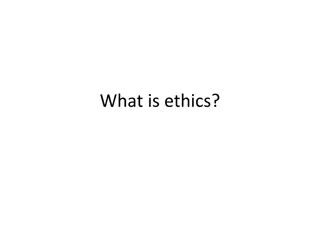Engineering Ethics and the Ford Pinto Case Study
On August 10, 1978, a tragic incident involving a Ford Pinto highlighted the ethical dilemmas faced by engineers and managers at Ford. Despite knowing the flaws in the gas tank design, management prioritized cost and speed to market over safety concerns, leading to devastating consequences. This case underscored the importance of upholding engineering standards and ethical responsibilities in product development.
Download Presentation

Please find below an Image/Link to download the presentation.
The content on the website is provided AS IS for your information and personal use only. It may not be sold, licensed, or shared on other websites without obtaining consent from the author. Download presentation by click this link. If you encounter any issues during the download, it is possible that the publisher has removed the file from their server.
E N D
Presentation Transcript
Enginering Ethics Prof.Dr.Halit Hami Z Kafkas University Faculty of Engineering and Architecture Head, Department of Computer Engineering Kars, Turkey, 36100 hamioz@yahoo.com
I used the Engineering Ethics book written by Charles B. Fleddermann (4th edition) for teaching as well as making the ppt presentations about the Engineering Ethics course Prof.Dr.Halit Hami Z Prof.Dr.Halit Hami OZ - Engineering Ethics Course 2
Engineering Ethics On August 10, 1978, a Ford Pinto was hit from behind on a highway in Indiana. The impact of the collision caused the Pinto s fuel tank to rupture and burst into flames, leading to the deaths of three teenage girls riding in the car. This was not the first time that a Pinto had caught on fire as a result of a rear-end collision. In the seven years following the introduction of the Pinto, there had been some 50 lawsuits related to rear-end collisions. However, this time Ford was charged in a criminal court for the deaths of the passengers. Prof.Dr.Halit Hami OZ - Engineering Ethics Course 3
Engineering Ethics This case was a significant departure from the norm and had important implica-tions for the Ford engineers and managers. A civil lawsuit could only result in Ford being required to pay damages to the victim s estates. A criminal proceeding, on the other hand, would indicate that Ford was grossly negligent in the deaths of the passengers and could result in jail terms for the Ford engineers or managers who worked on the Pinto. Prof.Dr.Halit Hami OZ - Engineering Ethics Course 4
Engineering Ethics The case against Ford hinged on charges that it was known that the gas-tank design was flawed and was not in line with accepted engineering standards, even though it did meet applicable federal safety standards at the time. During the trial, it was determined that Ford engineers were aware of the dangers of this design, but management, concerned with getting the Pinto to market rapidly at a price competitive with subcompact cars already introduced or planned by other manufacturers, had constrained the engineers to use this design. Prof.Dr.Halit Hami OZ - Engineering Ethics Course 5
Engineering Ethics The dilemma faced by the design engineers who worked on the Pinto was to balance the safety of the people who would be riding in the car against the need to produce the Pinto at a price that would be competitive in the market. They had to attempt to balance their duty to the public against their duty to their employer. Ultimately, the attempt by Ford to save a few dollars in manufacturing costs led to the expenditure of millions of dollars in defending lawsuits and payments to victims. Of course, there were also uncountable costs in lost sales due to bad publicity and a public perception that Ford did not engineer its products to be safe. Prof.Dr.Halit Hami OZ - Engineering Ethics Course 6
1.1 BACKGROUND IDEAS The Pinto case is just one example of the ethical problems faced by engineers in the course of their professional practice. Ethical cases can go far beyond issues of public safety and may involve bribery, fraud, environmental protection, fairness, honesty in research and testing, and conflicts of interest. During their undergraduate education, engineers receive training in basic and engineering sciences, problem-solving methodology, and engineering design, but generally receive little training in business practices, safety, and ethics. Prof.Dr.Halit Hami OZ - Engineering Ethics Course 7
1.1 BACKGROUND IDEAS This problem has been partially corrected, as many engineering education programs now have courses in what is called engineering ethics. Indeed, the Accreditation Board for Engineering and Technology (ABET), the body responsible for accrediting undergraduate engineering programs in the United States, has mandated that ethics topics be incorporated into undergraduate engineering curricula. The purpose of this course is to provide a text and a resource for the study of engineering ethics and to help future engineers be prepared for confronting and resolving ethical dilemmas, such as the design of an unsafe product like the Pinto, that they might encounter during their professional careers. Prof.Dr.Halit Hami OZ - Engineering Ethics Course 8
1.1 BACKGROUND IDEAS A good place to start a discussion of ethics in engineering is with definitions of ethics and engineering ethics. Ethics is the study of the characteristics of morals. Ethics also deals with the moral choices that are made by each person in his or her relationship with other persons. As engineers, we are concerned with ethics because these definitions apply to all of the choices an individual makes in life, including those made while practicing engineering. Prof.Dr.Halit Hami OZ - Engineering Ethics Course 9
1.1 BACKGROUND IDEAS For our purposes, the definition of ethics can be narrowed a little. Engineering ethics is the rules and standards governing the conduct of engineers in their role as professionals. Engineering ethics encompasses the more general definition of ethics, but applies it more specifically to situations involving engineers in their professional lives. Thus, engineering ethics is a body of philosophy indicating the ways that engineers should conduct themselves in their professional capacity. Prof.Dr.Halit Hami OZ - Engineering Ethics Course 10
1.2 WHY STUDY ENGINEERING ETHICS? Why is it important for engineering students to study engineering ethics? Several notorious cases that have received a great deal of media attention in the past few years have led engineers to gain an increased sense of their professional responsibilities. These cases have led to an awareness of the importance of ethics within the engineering profession as engineers realize how their technical work has far reaching impacts on society. The work of engineers can affect public health and safety and can influence business practices and even politics. Prof.Dr.Halit Hami OZ - Engineering Ethics Course 11
1.2 WHY STUDY ENGINEERING ETHICS? One result of this increase in awareness is that nearly every major corporation now has an ethics office that has the responsibility to ensure that employees have the ability to express their concerns about issues such as safety and corporate business practices in a way that will yield results and won t result in retaliation against the employees. Ethics offices also try to foster an ethical culture that will help to head off ethical problems in a corporation before they start. Prof.Dr.Halit Hami OZ - Engineering Ethics Course 12
1.2 WHY STUDY ENGINEERING ETHICS? The goal of this course is to sensitize you to important ethical issues before you have to confront them. You will study important cases from the past so that you will know what situations other engineers have faced and will know what to do when similar situations arise in your professional career. Finally, you will learn techniques for analyzing and resolving ethical problems when they arise. Prof.Dr.Halit Hami OZ - Engineering Ethics Course 13
1.2 WHY STUDY ENGINEERING ETHICS? Our goal is frequently summed up using the term moral autonomy. Moral autonomy is the ability to think critically and independently about moral issues and to apply this moral thinking to situations that arise in the course of professional engineering practice. The goal of this course, then, is to foster the moral autonomy of future engineers. Prof.Dr.Halit Hami OZ - Engineering Ethics Course 14
1.2 WHY STUDY ENGINEERING ETHICS? The question asked at the beginning of this section can also be asked in a slightly different way. Why should a future engineer bother studying ethics at all? After all, at this point in your life, you re already either a good person or a bad person. Good people already know the right thing to do, and bad people aren t going to do the right thing no matter how much ethical training they receive. The answer to this question lies in the nature of the ethical problems that are often encountered by an engineer. In most situations, the correct response to an ethical problem is very obvious. For example, it is clear that to knowingly equip the Pinto with wheel lugs made from substandard, weak steel that is susceptible to breaking is unethical and wrong. This action could lead to the loss of a wheel while driving and could cause numerous accidents and put many lives at risk. Of course, such a design decision would also be a commercial disaster for Ford. Prof.Dr.Halit Hami OZ - Engineering Ethics Course 15
1.2 WHY STUDY ENGINEERING ETHICS? However, many times, the ethical problems encountered in engineering practice are very complex and involve conflicting ethical principles. For example, the engineers working on the Pinto were presented with a very clear dilemma. Trade-offs were made so that the Pinto could be successfully marketed at a reasonable price. One of these trade-offs involved the placement of the gas tank, which led to the accident in Indiana. So, for the Ford engineers and managers, the question became the following: Where does an engineering team strike the balance between safety and affordability and, simultaneously, between the ability of the company to sell the car and make a profit? Prof.Dr.Halit Hami OZ - Engineering Ethics Course 16
1.2 WHY STUDY ENGINEERING ETHICS? These are the types of situations that we will discuss in this course. The goal, then, is not to train you to do the right thing when the ethical choice is obvious and you already know the right thing to do. Rather, the goal is to train you to analyze complex problems and learn to resolve these problems in the most ethical manner Prof.Dr.Halit Hami OZ - Engineering Ethics Course 17
1.3 ENGINEERING IS MANAGING THE UNKNOWN One source of the ethical issues encountered in the course of engineering practice is a lack of knowledge. This is by no means an unusual situation in engineering. Engineers often encounter situations in which they don t have all of the information that is needed. By its nature, engineering design is about creating new devices and products. When something is new, many questions need to be answered. How well does it work? How will it affect people? What changes will this lead to in society? How well will this work under all of the conditions that it will be exposed to? Is it safe? If there are some safety concerns, how bad are they? What are the effects of doing nothing? The answers to these questions are often only partly known. Prof.Dr.Halit Hami OZ - Engineering Ethics Course 18
1.3 ENGINEERING IS MANAGING THE UNKNOWN So, to a large extent, an engineer s job is to manage the unknown. How does an engineer accomplish this? Really, as an engineer you can never be absolutely certain that your design will never harm anyone or cause detrimental changes to society. But you must test your design as thoroughly as time and resources permit to ensure that it operates safely and as planned. Also, you must use your creativity to attempt to foresee the possible consequences of your work. Prof.Dr.Halit Hami OZ - Engineering Ethics Course 19
1.4 PERSONAL VS. PROFESSIONAL ETHICS In discussing engineering ethics, it is important to make a distinction between personal ethics and professional, or business, ethics, although there isn t always a clear boundary between the two. Personal ethics deals with how we treat others in our day-to-day lives. Many of these principles are applicable to ethical situations that occur in business and engineering. However, professional ethics often involves choices on an organizational level rather than a personal level. Many of the problems will seem different because they involve relationships between two corporations, between a corporation and the government, or between corporations and groups of individuals. Frequently, these types of relationships pose problems that are not encountered in personal ethics. Prof.Dr.Halit Hami OZ - Engineering Ethics Course 20
1.5 THE ORIGINS OF ETHICAL THOUGHT Before proceeding, it is important to acknowledge in a general way the origins of the ethical philosophies that we will be discussing in this course. The Western ethical thought that is discussed here originated in the philosophy of the ancient Greeks and their predecessors. It has been developed through subsequent centuries by many thinkers in the Judeo Christian tradition. Interestingly, non-Western cultures have independently developed similar ethical principles. Prof.Dr.Halit Hami OZ - Engineering Ethics Course 21
1.5 THE ORIGINS OF ETHICAL THOUGHT Although for many individuals, personal ethics are rooted in religious beliefs, this is not true for everyone. Certainly, there are many ethical people who are not religious, and there are numerous examples of people who appear to be religious but who are not ethical. So while the ethical principles that we will discuss come to us filtered through a religious tradition, these principles are now cultural norms in the West, and as such, they are widely accepted regardless of their origin. We won t need to refer explicitly to religion in order to discuss ethics in the engineering profession. Prof.Dr.Halit Hami OZ - Engineering Ethics Course 22
1.6 ETHICS AND THE LAW We should also mention the role of law in engineering ethics. The practice of engi-neering is governed by many laws on the international, federal, state, and local levels. Many of these laws are based on ethical principles, although many are purely of a practical, rather than a philosophical, nature. Prof.Dr.Halit Hami OZ - Engineering Ethics Course 23
1.6 ETHICS AND THE LAW There is also a distinction between what is legal and what is ethical. Many things that are legal could be considered unethical. For example, designing a process that releases a known toxic, but unregulated, substance into the environment is probably unethical, although it is legal. Prof.Dr.Halit Hami OZ - Engineering Ethics Course 24
1.6 ETHICS AND THE LAW Conversely, just because something is illegal doesn t mean that it is unethical. For example, there might be substances that were once thought to be harmful, but have now been shown to be safe, that you wish to incorporate into a product. If the law has not caught up with the latest scientific findings, it might be illegal to release these substances into the environment, even though there is no ethical problem in doing so. Prof.Dr.Halit Hami OZ - Engineering Ethics Course 25
1.6 ETHICS AND THE LAW As an engineer, you are always minimally safe if you follow the requirements of the applicable laws. But in engineering ethics, we seek to go beyond the dictates of the law. Our interest is in areas where ethical principles conflict and there is no legal guidance for how to resolve the conflict. Prof.Dr.Halit Hami OZ - Engineering Ethics Course 26
1.7 ETHICS PROBLEMS ARE LIKE DESIGN PROBLEMS At first, many engineering students find the types of problems and discussions that take place in an engineering ethics class a little alien. The problems are more open ended and are not as susceptible to formulaic answers as are problems typically assigned in other engineering classes. Ethics problems rarely have a correct answer that will be arrived at by everyone in the class. Surprisingly, however, the types of problem-solving techniques that we will use in this course and the nature of the answers that result bear a striking resemblance to the most fundamental engineering activity: engineering design. Prof.Dr.Halit Hami OZ - Engineering Ethics Course 27
1.7 ETHICS PROBLEMS ARE LIKE DESIGN PROBLEMS The essence of engineering practice is the design of products, structures, and processes. The design problem is stated in terms of specifications: A device must be designed that meets criteria for performance, aesthetics, and price. Within the limits of these specifications, there are many correct solutions. There will, of course, be some solutions that are better than others in terms of higher perfor-mance or lower cost. Frequently, there will be two (or more) designs that are very different, yet perform identically. For example, competing automobile manufacturers may design a car to meet the same market niche, yet each manufacturer s solution to the problem will be somewhat different. In fact, we will see later that although the Pinto was susceptible to explosion after rear-end impact, other similar subcompact automobiles were not. In engineering design, there is no unique correct answer! Prof.Dr.Halit Hami OZ - Engineering Ethics Course 28
1.7 ETHICS PROBLEMS ARE LIKE DESIGN PROBLEMS Ethical problem solving shares these attributes with engineering design. Although there will be no unique correct solution to most of the problems we will examine, there will be a range of solutions that are clearly right, some of which are better than others. There will also be a range of solutions that are clearly wrong. There are other similarities between engineering ethics and engineering design. Both apply a large body of knowledge to the solution of a problem, and both involve the use of analytical skills. So, although the nature of the solutions to the problems in ethics will be different from those in most engineering classes, approaches to the problems and the ultimate solution will be very similar to those in engineering practice. Prof.Dr.Halit Hami OZ - Engineering Ethics Course 29
1.8 CASE STUDIES Before starting to learn the theoretical ideas regarding engineering ethics and before looking at some interesting real-life cases that will illustrate these ideas, let s begin by looking at a very well-known engineering ethics case: the space shuttle Challenger accident. This case is presented in depth at the end of this chap- ter, but at this point we will look at a brief synopsis of the case to further illustrate the types of ethical issues and questions that arise in the course of engineering practice. Prof.Dr.Halit Hami OZ - Engineering Ethics Course 30
Challenger accident Many readers are already familiar with some aspects of this case. The space shuttle Challenger was launched in extremely cold weather. During the launch, an O-ring on one of the solid-propellant boosters, made more brittle by the cold, failed. This failure led to an explosion soon after liftoff. Engineers who had designed this booster had concerns about launching under these cold conditions and recommended that the launch be delayed, but they were overruled by their management (some of whom were trained as engineers), who didn t feel that there were enough data to support a delay in the launch. The shuttle was launched, resulting in the well-documented accident. Prof.Dr.Halit Hami OZ - Engineering Ethics Course 31
Challenger accident On the surface, there appear to be no engineering ethical issues here to discuss. Rather, it seems to simply be an accident. The engineers properly recommended that there be no launch, but they were overruled by management. In the strictest sense, this can be considered an accident no one wanted the Challenger to explode but there are still many interesting questions that should be asked. When there are safety concerns, what is the engineer s responsibility before the launch decision is made? After the launch decision is made, but before the actual launch, what duty does the engineer have? If the decision doesn t go the engineer s way, should she complain to upper management? Or should she bring the problem to the attention of the press? After the accident has occurred, what are the duties and responsibilities of the engineers? If the launch were successful, but the postmortem showed that the O-ring had failed and an accident had very nearly occurred, what would be the engineer s responsibility? Even if an engineer moves into management, should he separate engineering from management decisions? Prof.Dr.Halit Hami OZ - Engineering Ethics Course 32
Challenger accident These types of questions will be the subject of this course. As an engineer, you will need to be familiar with ideas about the nature of the engineering profession, ethical theories, and the application of these theories to situations that are likely to occur in professional practice. Looking at other real-life cases taken from newspaper accounts and books will help you examine what engineers should do when con- fronted with ethically troubling situations. Many cases will be postmortem examina-tions of disasters, while others may involve an analysis of situations in which disaster was averted when many of the individuals involved made ethically sound choices and cooperated to solve a problem. Prof.Dr.Halit Hami OZ - Engineering Ethics Course 33
Challenger accident A word of warning is necessary: The clich Hind-sight is 20/20 will seem very true in engineering ethics case studies. When studying a case several years after the fact and knowing the ultimate outcome, it is easy to see what the right decision should have been. Obviously, had the National Aeronautics and Space Administration (NASA) owned a crystal ball and been able to predict the future, the Challenger would never have been launched. Had Ford known the number of people who would be killed as a result of gas-tank failures in the Pinto and the sub-sequent financial losses in lawsuits and criminal cases, it would have found a better solution to the problem of gas-tank placement. Prof.Dr.Halit Hami OZ - Engineering Ethics Course 34
